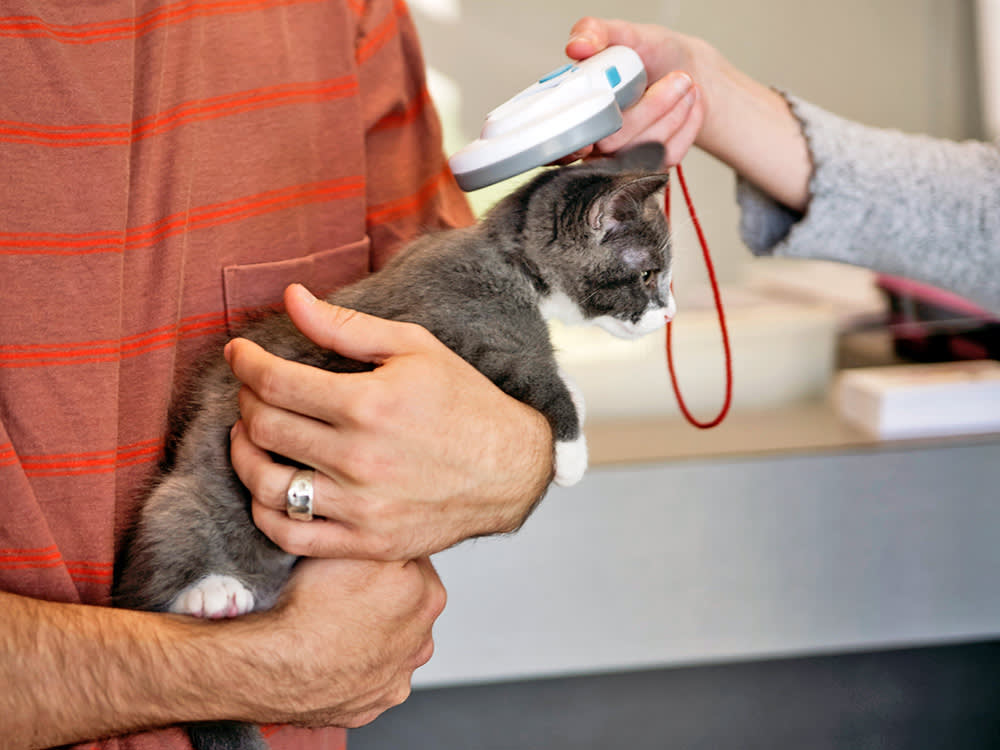Cat Parents! The Microchip Law is Here – Avoid £500 Fine
Microchipping your cat is quick and painless – and it’s now required by law
Many pet parents get their four-legged friends microchipped as a matter of course – it’s just another thing for them to check off the list when they get a new cat or dog.
Not everyone remembers though. Perhaps you use a cat trackeropens in a new tab and consider microchipping less useful, perhaps you acquired an older catopens in a new tab and never thought to check if a microchip was in place. Whatever the reason, research from the government in 2023 indicated that around 2.3 million of the nine million pet cats in England aren’t microchippedopens in a new tab. And, to address this, Parliament passed a lawopens in a new tab making microchipping pet cats compulsory.
The law has come into effect on 10 June 2024, and you can get a fine of up to £500opens in a new tab if your cat isn’t chipped. Here’s everything you need to know about the new law.
What is a cat microchip?
A microchip is a tiny device – around the size of a grain of rice – that gets inserted under your cat’s skin. It contains a unique code that links your cat to you through an online database. Vets and rescue centres can scan cats for microchips to help reunite them with their parents if they go missingopens in a new tab.
In the vast majority of cases, microchips will last for your pet’s lifetime. However, in the extremely rare cases where a chip becomes faulty, the manufacturer will usually provide a replacement, which can be inserted alongside the original chip.
What does the new microchip law say?
From 10 June 2024, cats in England must now be microchipped and registered on a database by the time they are 20 weeks old. The chip must be fitted by a trained professional, and the government advises asking your vet, local council or local rescue and rehoming centre if they can microchip your cat.
When you microchip your cat, they will need to be registered on one of a number of government-approved databases (there are quite a fewopens in a new tab, but they talk to each other so theoretically, if you search one, you’re searching them all), so you’ll be asked for your address and contact details. You are responsible for keeping your details up to date – if you move house, for example. Likewise, if you rehome your cat, you should contact the database.
The government recommends asking for proof from the breeder or rescue centre that a microchip has been fitted before you get a cat. You might ask to see the microchip certificate, the cat’s vet records or their pet passportopens in a new tab. You might be able to find microchip information in their insurance papersopens in a new tab, too.
If your cat is found to not be microchipped, or is registered on a database that’s not on the government’s list, you’ll be given a 21-day period to get your cat microchipped. If you don’t you can be fined up to £500.
Some cats are exempt. Free-living cats with little or no human interaction or dependency, like farm, feral or community cats, will not be legally required to get microchipped.
This law only covers England. In Scotland, Wales and Northern Ireland, microchipping cats will not become compulsory, but is still strongly recommended.
How much does it cost to microchip my cat?
The cost of microchipping a cat can vary, but is usually between £10 and £30 – a lot cheaper than the potential fine! Some vets will include a microchip in their health plans, too, and can do it while your cat is being spayed or neutered.
Some charities offer microchipping for free, or at a discount. The RSPCA has even hosted a free microchipping weekend in the past, in a bid to encourage as many pet parents to get their cats and dogs microchipped.
If you adopt a cat, the charity or rescue centre may have already taken care of the microchipping for you, or your cat’s previous owners may have already microchipped them. But, while you won’t need to pay for a microchip, you will need to ensure that your cat’s details on the database are updated, and there may be a charge for this.
Does microchipping hurt my cat?
The procedure itself is quick and simple, and no more painful than an injection. If your cat is getting their microchip while they’re being spayed or neuteredopens in a new tab, they’ll be under general anaesthetic anyway, and won’t feel a thing.
There’s no need for any recovery time afterwards, and your cat won’t feel any pain or discomfort. More than likely, they won’t be aware that it’s there.
What are the benefits and limitations of microchipping your cat?
If your cat is lost or stolen, you should contact the database right away. They can make a note, and this means that your cat has a better chance of being reunited with you. Collars and tags can be removed, but a microchip is there for life.
However, a microchip won’t allow you to track your catopens in a new tab, and there are no guarantees that you’ll find your cat if they go missing, even with a chip.
It’s important to remember that a microchip is not legal proof of ownership by itself, too. According to the new legislation, the person who cares for and keeps the cat in their home is called a ‘keeper’ rather than an owner, and per the law a keeper is not necessarily the legal owner. However, the microchip must be registered to the keeper.
To prove ownership, you might need to provide evidence like insurance or veterinary records, or proof of purchase or adoption.
If your cat isn’t microchipped, the thought of getting it sorted might be daunting at first, but the process is more simple than you might think. And, with a month to go before the law comes into force, there’s plenty of time to get that microchip.










